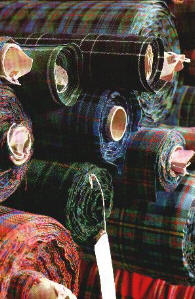|
|
|
|
|
|
|
|
 |
 |
|
|
|
| ||
|
| ||||
|
SETON FAMILY TARTANS Suggestive Tartans for Family Branches It is important to note that the first Seton tartan was not designed by the Seton family; no consultation ever took place with any representative nor anyone who knew anything of our history, or our place in Scottish history. It appeared in the volume by the Sobieski-Stuart (Allen) brothers in the mid-1800's called the Vestarium Scoticum, and all scholars of the subject agree that the work lacks credibility. Nevertheless, while many families in Scotland have likewise had tartan's promulgated in their name from this origin, it is the sentiment of the tradition that matter most and many generations of Seton's have borne the "old family version", proudly. The tartans here are designed to better represent the family with colours, or tinctures, that are long known to have been historically associated with the Seton's and the Seton Arms. These designs were created by using the Royal Stewart, Hamilton, Hay and Hepburn tartans; which families had long associations, descent and history with the Seton family. This in no way constitutes a certified-list of official tartans. It simply serves to illustrate design possibilities, as these tartans were designed by the author. A few of the guidelines used are: The Red ground: signifies the ancient royal bloodline and the purity of the Seton bloodline, and of the tincture of three crescents and double-tressure of the Seton Arms. The White center stripe in the center: signifies the purity of purpose of the family, illustrated in the Seton family creed of "Un Dieu, Un Foy, Un Roy, Un Loy", which is old Scots-French for, "One God, One Time, One King, One Loyalty", written by the former head of the family George, 7th Lord Seton and which was engraved above the entrance of the Palace of Seton; it also emulates that in Queen Victoria's Stewart tartan and commemorates Sir Henry-John Seton of Abercorn who was a groom-in-waiting to Her Majesty Queen Victoria. The Royal Blue stripes: signify the Royal connections of the Seton family, having inter-married with the Royal House on at least four occasions. The Violet stripes: commemorate the noblility of the Seton Family, and also serve to illustrate the connections with the Montgomerie-Seton family. The Yellow stripes: added from the shield-ground-tincture of the Seton Arms, and also taken from Gordon Family tartan who are male-descent Seton's. The Black stripes: commemorate the many Catholic Clergy in the family and for St. Elizabeth Ann Seton, the first American Saint. The Green stripes: represent the many lands that the Seton's held in Scotland; most notably the Seton lands and garden's and orchard's at the Palace of Seton and at Winton House; the lands and garden's at Niddry Castle; the lands and garden's Chancellor Seton's Fyvie Castle and Pinkie House; the Seton Hereditary Armour Bearer's to the King at Touch House; the lands and garden's of Meldrum House; and the popular Great Garden of Pitmedden of Sir Alexander Seton, Lord Pitmedden and 1st Baronet of Pitmedden.
The following are examples of Seton Tartan's: Old Seton Family Tartan The Chief's Tartan The Seton Family Red The Seton Grey The Seton Black Specialized Family-Branch Tartans Parbroath Meldrum Mounie Touch |
 | |||
|
|
|
|
|
|
|
|
|
|
|
|
|
|
|
|
|
|
|
|
|
|
